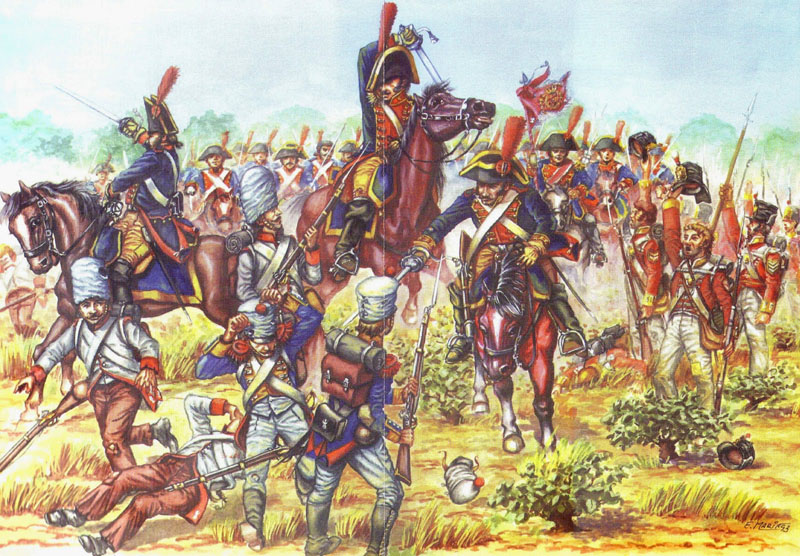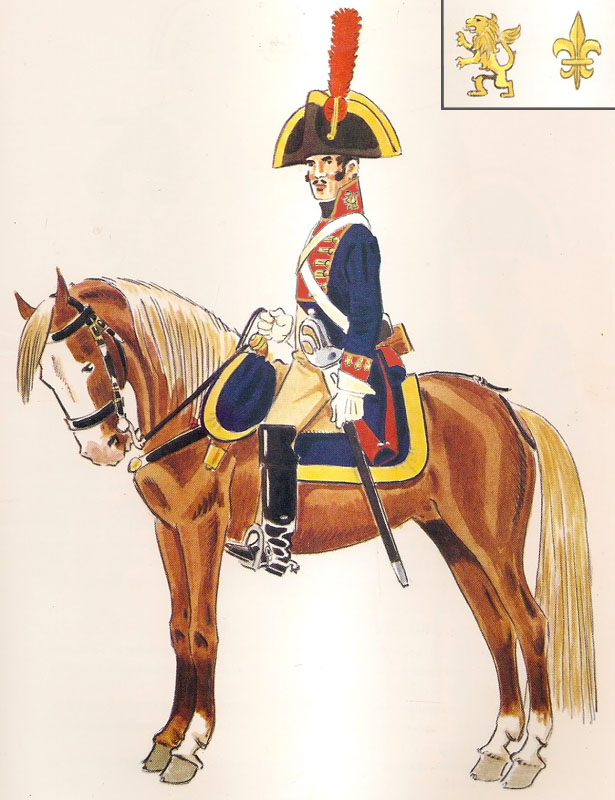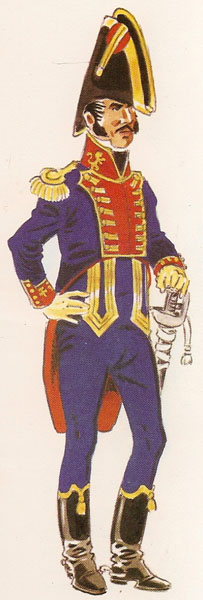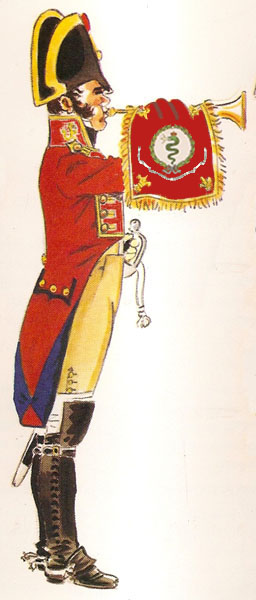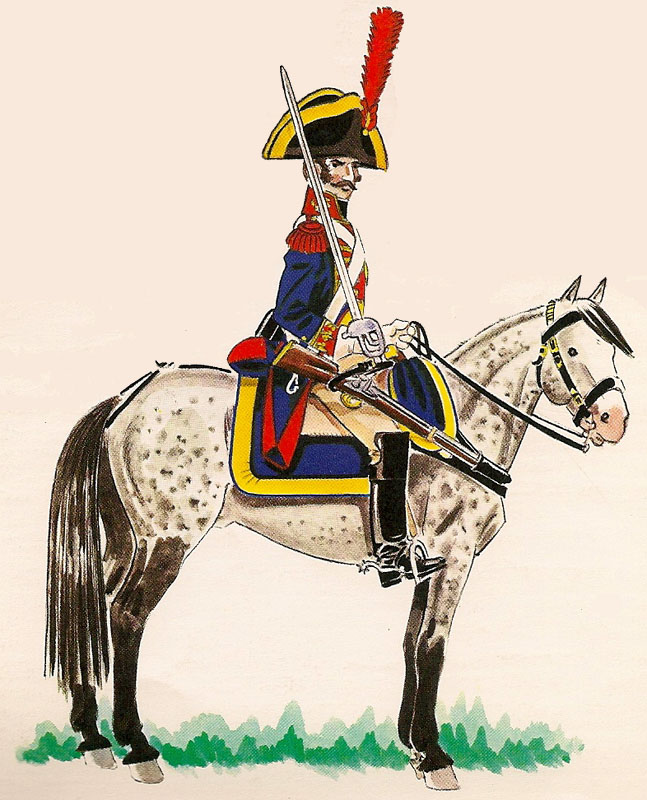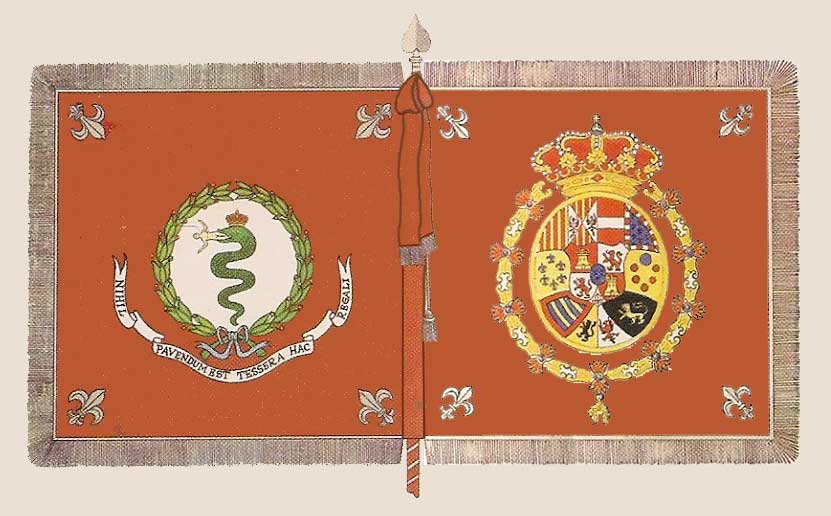|
Cavalry Regiment del ReyHistoryThe King's Heavy Cavalry Regiment (Caballería de Línea Regimiento del Rey) hereafter referred to as the Regiment del Rey is Spain's oldest cavalry regiment being officially formed in 1536 (or perhaps 1538, sources seem to differ). In 1536 Lombardy was a Spanish domain and the regiment was formed in Milan, thus being originally known as the Tercio de Milán. In 1661 it was merged with other cavalry companies from Piedmont and Lombardy to form the Trozo de Caballería de Milán. In 1707 the unit was again merged, this time wit that of the Marquis of Valdefuertes. Finally in 1763 the cavalry of Milan and Flanders were merged, creating the Regimiento del Rey, however it retained the Arms of Milan on its standard (a snake eating a man). By the time of the Napoleonic wars, the regiment had few if any Italians left in its ranks. In 1807 and 1808 the regiment formed part of the Marquis de la Romana's Expeditionary Corps in Northern Europe. After the outbreak of hostilities between Spain and France, it was returned to Spain by the British Royal Navy. The men were embarked at Nyberg for shipment to Santander, but without their horses. When landed, the 4 squadrons had 37 officers and 551 men present. The regiment marched with Romana's other cavalry from Santander to Extremadura to get new mounts. It then fought at Uclés on 13th January 1809, Medellin on 28th March 1809 and then Talavera on 28th March 1809. It later fought at Ocaña on 18-19 November 1809 and Sagunto on 25 October 1811. Directly after the Peninsular War, the regiment became the King's Cuirassiers (El Regimiento Coraceros del Rey, 1.º de Caballería). Today's Regimiento de Lanceros del Rey trace their origin back to the Cavalry Regiment del Rey and are part of the Guards of the King of Spain, H.M. Don Juan Carlos I. The Milanese snake is still worn on the collar of their parade dress. TalaveraTalavera was perhaps the regiment's greatest hour during the Peninsular War where it formed part of Lieutenant-General de Henestrosa's 1st Cavalry Division. The Regiment del Rey's charge must have surprised its friends as much as it shocked its enemies; this sort of thing was just not expected from Spanish cavalry. Towards the end of the battle, at 4pm in the afternoon, Général de division Leval's "Confederation of the Rhine" division of the 4th Corps attacked the Pajar de Vergara, a redoubt on a hill, for the second time. The battery had been recently reinforced by more Spanish troops and Leval came under intense artillery and musket fire. Once again the Germans wavered and retreated without being pursued by the defenders. Colonel Don José Maria de Lastra commanding the Regiment del Rey saw his chance and led his 348 troopers in pursuit. The retreating Hesse-Darmstadt and Frankfurt Infantry were caught in the flank as they tried to form square. The troopers hacked down many Germans before they managed to flee into the safety of the nearby olive groves. The regiment then went on to charge the 2 artillery batteries that were coming up in support of the infantry and 10 cannon were overrun of which 4 (3 Baden and 1 Hesse-Darmstadt) were dragged back to the Pajar de Vergara redoubt. The regiment was highly honoured and praised in Capitán General Cuesta's after battle report: "Its intrepid attack and destruction of a column of enemy infantry. Its colonel, Don José Maria de Lastra, was wounded during the charge and was succeeded with valour by lieutenant colonel Don Rafael Valparda. Captain Don Francisco de Sierra gained much distinction by taking a cannon while vanquishing its defenders; Ensign Don Pablo de Cataneo, of 16 years of age, slew four Frenchmen, and all officers and men of the regiment manifested proof of its valour and discipline." Oman, who was never known for his praise of the Spanish, wrote in his history: "The Spaniards had little to do upon July 28, but what little they had to do was well done. The charge of the cavalry regiment Rey was well timed and gallantly delivered. The few battalions engaged near the Pajar de Vergara and in Bassecourt's division behaved steadily. The artillery sent to aid the British was manfully worked and did good service,"
Organisation1803The cavalry regulations of 1803 stated that Regimiento del Rey was to be th 1st regiment of Cavallería de Línea. The Spanish used the term Line Cavalry to describe what is now called Heavy Cavalry and would equate to the British Heavy Dragoons of the time. From 30 January 1803, all cavalry regiments were to have the same organisation, consisting of a regimental staff and 5 squadrons each of two companies. The first four squadrons were field squadrons and carried standards, the 5th squadron was a to be a depot squadron and had no standard. The regimental staff consisted of:
1 Colonel Each company consisted of:
1 Captain The Carabineros were elite troopers selected in for "the best behavior, agility and ruggedness" mounted on the best horses often used as scouts or guides. Men without horses would remain at the depot. Thus the regiment at full establishment should have consisted of 674 men and 544 horses plus officers. 1808In June 1808 the Regiment del Rey had 5 squadrons with 38 officers and 634 men mounted on 467 horses. This was much better than most other cavalry regiments, most of which had under half their expected compliment of horses. Unfortuneately the regiment had to return to Spain from Denmark without its horses. From 1 October 1808, all cavalry regiments were to have the same organisation, consisting of a regimental staff and 4 squadrons each of three companies. The staff consisted of 12 officers and 6 men. Each company had 3 officers and 61 men but only 53 horses. Thus a full strength regiment could field at most 654 officers and men, although it is unlikely that the establishment was reached because of the trying times! 1809From 30 January 1809, each company was to consist of 81 men and 71 horses. On 15 July 1809, all cavalry regiments were reduced to 3 squadrons. 1811From 6 April 1811, due to the shortage of horses, two squadrons were to be mounted and one dismounted. UniformsRomana's CorpsThe uniforms of Romana's Corps were well documented by the Suhr brothers when they were in Hamburg in late 1807 before moving to Denmark in early 1808. The Regiment del Rey arrived in Hamburg wearing the old style 1802 uniforms but received 1805 model uniforms while they were there. The new uniforms and equipment probably came from Paris. They were still wearing these 1805 uniforms when in August 1808 they boarded British ships and were returned to the Peninsular. Early WarIn 1805 uniforms with regimental distinctions were re-adopted. The Regiment del Rey wore a dark blue long-tailed coat. Collar, cuffs, lapels, pocket piping and turnbacks were scarlet. Buttons were brass and yellow lace edged the collar, lapels and button holes. Button hole lace was regulation for the four royal regiments. The collar badge was a yellow rampant lion and each cuff had three yellow fleurs-de-lis badges. The waistcoat and breeches were buff. Footwear was ideally black long cavalry boots but was sometimes replaced with long black gaiters buttoning up the outside worn with shoes. The headgear was a black bicorne, edged yellow with the red Spanish cockade and red plume. They were issued with a dark blue cape, with a red collar. The saddlecloth was dark blue edged in yellow. Heavy cavalry were armed with a straight sword, two pistols and a carbine. The carbine was secured by a hook to the carbine belt hung over the left shoulder. Sergeants did not carry the carbine. Officers: They had the same style uniform as that of the troopers but of better quality. The coat was long tailed and had lace, buttons, badges and epaulettes in gold. The bicorne was edged with gold lace. Long black boots and buff breeches were worn, although non regulation hussar style dark blue breeches with gold lace loops or plain white breeches could be worn as well as gold laced Hessian boots. Their saddlecloth was dark blue edged in gold. Trumpeter: They had the same style uniform as that of the troopers. The coat was scarlet as were the collar, cuffs, lapels. The pocket piping and turnbacks dark blue. Where possible, they would have ridden greys. The saddlecloth may have been red edged in yellow and the cape red. Trumpets were brass, and it was common practice to have the regiment's arms on the trumpet banner. There is no existing trumpeter uniform or illustration, so I have chosen one interpretation of the regulations. However there is an alternative possibility, being the King's regiment, the trumpeter could, like the guards, have worn the King's livery, a dark blue coat with red facings (collar, cuffs, lapels, turnbacks and pocket piping) edged with the red and white livery lace.
Late WarThe 1805 uniform regulations applied to the cavalry throughout the war. In 1814 the regiment was recorded as having dark blue coat, scarlet collar, cuffs and lapels, yellow button-hole lace and brass buttons. Buff waistcoat and breeches and a dark blue cloak were worn. This agrees with the 1805 regulations, however the cut of the uniform had probably taken a more modern form, for example with shorter coat tails. In the later period cavalry could have had bell-topped shakos or helmets. One illustration shows a trooper in bell-topped shako for the Battle of Ocaña in November 1809 but I can find no other evidence for or against this. Rank distinctionsThis list is based upon the 1803 regulations. The rank of squadron commander was created in July 1810. Field grade officers are sometimes shown wearing two gold epaulettes as well as the lace stripes listed below.
Colonel: Three gold lace stripes around the coat cuffs. A "counter-epaulette" (with no fringe) was sometimes worn on the opposite shoulder of those who wore only a single epaulette. FlagsRoyal Decree 1768The Royal Decree 1768 required regiments of cavalry (guard, line, dragons and light) to use standards of damask or velvet in blue, red or white depending on the regiment, with the royal arms embroidered on the obverse, and the regiment's arms on the reverse. In the 4 corners, the fleurs de lys must be embroidered in gold or silver. Cravats for all banners and flags should be of red colour, this being the national colour. The finials and fringes were to be gold or silver depending on the regiment. This decree remained in force until 1833. Regiment del ReyThe regiment carried one standard per squadron, up to a maximum of four. The standard had a field of crimson with a silver fringe. The stave was red and yellow striped and the finial was silver. The stave was carried in a crimson shoulder belt adorned with silver fringes. The cravats were red colour, this being the national colour and cords were silver. On the obverse (or front, when the stave is to the left), the field contained the royal coat of arms in the centre with a silver fleur-de-lis in each corner. On the reverse (or rear, when the stave is to the right), in the centre of the field was the coat of arms of Milan (a snake eating a man) above a scroll containing the motto: NIHIL EST PAVENDUM TESSERA HAC REGALI (Nothing to fear in the shadow of the royal standard). In each corner was a silver fleur-de-lis.
Sources
|


